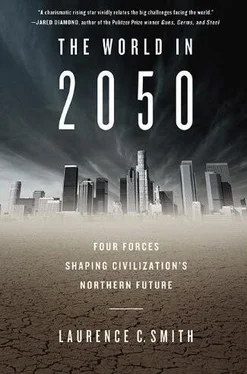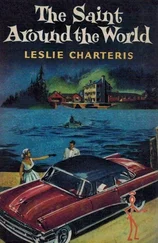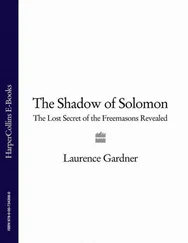If you enjoy watching wildlife in your backyard, perhaps you’ve noticed something. All around the world there are animals, plants, fish, and insects creeping to higher latitudes and elevations. From spittlebugs in California to butterflies in Spain and trees in New Zealand, it is a broad pattern that biologists are discovering. By 2003 a global inventory of this phenomenon found that on average, plants and animals are shifting their ranges about six kilometers toward the poles, and six meters higher in elevation, every decade. Over the past thirty years phenological cycles—the annual rhythm of plant flowering, bird migrations, birthing babies, and so on—have shifted earlier in the spring by more than four days per decade. 5
If these numbers don’t sound large to you, they should. Imagine your lawn crawling north, away from your house, at a speed of five and one-half feet each day. Or that your birthday arrived ten hours sooner each year. That’s how fast these biological shifts are happening. Life-forms are migrating—and it’s going on right outside your window.
The 2006 pizzly story—like the record-shattering Atlantic hurricane season in 2005, or the strange weather patterns that rained out the Winter Olympic Games in Vancouver while burying the eastern U.S. seaboard with “Snowpocalypse” in 2010 6—is yet another example of something that might have been triggered by climate change or might not. Such events are eye-catching in the news of the day but not, taken in isolation, conclusive of anything. In contrast, while the painstaking statistical analyses of decades of field research on spittlebugs and trees may not rouse the daily news cycle, it does me. It is deeply important, a compelling discovery that provides real understanding about the future. It is a megatrend, and megatrends are what this book is all about.
This is a book about our future. Climate change is but one component of it. We will explore other big trends as well, in things like human population, economic integration, and international law. We will study geography and history to show how their preexisting conditions will leave lasting marks on the future. We will look to sophisticated new computer models to project the futures of gross domestic product, greenhouse gases, and supplies of natural resources. By examining these trends collectively, and identifying convergences and parallels between them, it becomes possible to imagine, with reasonable scientific credibility, what our world might look like in forty years’ time, should things continue on as they are now. This is a thought experiment about our world in 2050.
It can be fun imagining what our world might look like by then. Robots and flying cars? Custom-grown body parts? A hydrogen economy? As any disappointed sci-fi buff will tell you, the pace of reality is usually slower than human imagination. Fans of George Orwell’s book 1984, the television series Lost in Space and Space 1999, the films 2001: A Space Odyssey, and (it’s looking like) Blade Runner —set in a perpetually raining 2019 Los Angeles—see their landmark years come and go. But outside of the ongoing technical explosions in information and biotechnologies, our lives are considerably less different than the writers of these fictional works imagined they would be.
We’ve discovered quarks and flung people into space, yet still depend on the internal combustion engine. We’ve cracked DNA and grown a human ear on a mouse’s back, yet are still dying of cancer. We’ve created fluorescent green pigs by inserting jellyfish genes into them ( Green Eggs and Ham, anyone?), yet still catch wild fish from the sea and use dirt and water to grow our food. Nuclear power is but a pale shadow of what was hoped for it in the 1950s. We still use boats, trucks, and trains to move goods. And even in this unprecedented era of globalization, the fundamental principles of our markets and economies differ surprisingly little from the days of Adam Smith, more than two hundred years ago.
But in other, sneakier ways, things have changed profoundly. Imagine describing to a 1950 California tomato farmer how in the next fifty years he would grow genetically programmed seeds, see the water in his state tilted from one end to the other, and experience a tripling of the state’s population. Imagine explaining he would one day compete with Chinese farmers to sell tomatoes to Italians who would blend them with beans from Mexico to make canned goods for British supermarkets. 7
Any of these would blow our yesteryear farmer’s mind. But to us, they are familiar, even boring. They fly below our radar because they have crept upon us, hiding in plain sight over the course of decades. But that doesn’t mean transformations like these aren’t huge, fast, and profound. Big changes often just sort of ease their way in. And quietly change the world.
What will our world look like in 2050? Our distribution of people and power? The state of the natural world? Which countries will lead, and which ones suffer? Where do you think you’ll be in 2050?
The answers to these questions, at least in this book, derive from a core argument: The northern quarter of our planet’s latitudes will undergo tremendous transformation over the course of this century, making them a place of increased human activity, higher strategic value, and greater economic importance than today. I loosely define this “New North” as all land and oceans lying 45° N latitude or higher currently held by the United States, Canada, Iceland, Greenland (Denmark), Norway, Sweden, Finland, and Russia.
These eight countries, which control vast territories and seas extending as far north as the Arctic Ocean, comprise a new “Northern Rim” roughly encircling that ocean. Developments in these Northern Rim countries, here coined the NORC countries, or “NORCs,” are explored in Parts II and III (Chapters 5 through 10). Part I (Chapters 2 through 4) presents powerful worldwide trends in human population, economics, energy and resource demand, climate change, and other factors keenly important to our global civilization and ecosystem. Besides imagining what life might be like for most of us by 2050, these first chapters identify some critical world pressures that are stimulating the New North into existence.
Before beginning our travels around this 2050 world, there are some rules to establish.
Fortunately, we have the tools, the models, and the knowledge to construct an informed thought experiment of what we might expect to see unfold over the next forty years. However, as in any experiment, we must first define the assumptions and ground rules upon which its outcomes are contingent.
1. No Silver Bullets.
Incremental advances in technology for the next forty years are assumed. No cold nuclear fusion or diesel-growing fungus 8will suddenly solve all our energy problems; no God-like genetic engineering to grow wheat without water. This is not to say a radical technology breakthrough can’t or won’t happen; only that the possibility will not be entertained here.
2. No World War III.
The two “world” wars in the first half of the twentieth century recast the map and forged economic, political, and infrastructural changes that reverberate to this day. A nuclear or major, multicountry, conventional war like World War II would be a game changer and is not imagined here (indeed, empirical evidence suggests that over the long run we may be becoming somewhat less violent 9). However, the possibility of lesser armed conflicts, like the ones ongoing today in the Middle East and Africa, is evaluated. Major laws and treaties, once made, are assumed to stay in place.
Читать дальше












